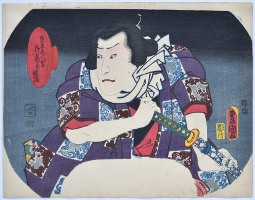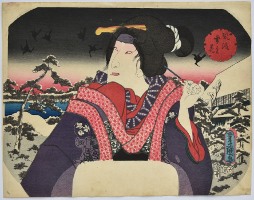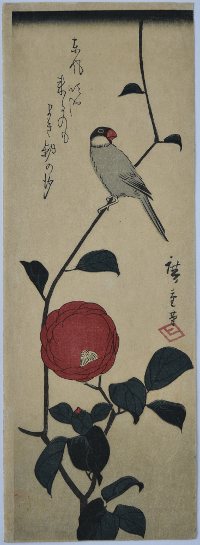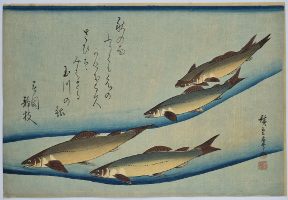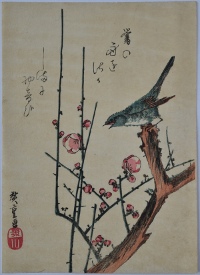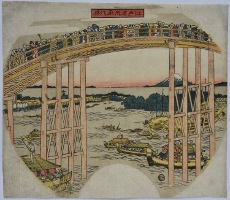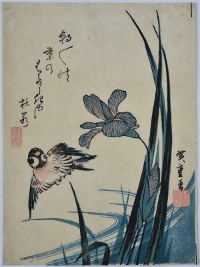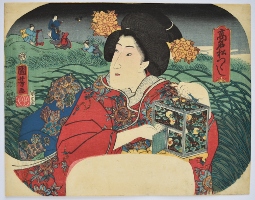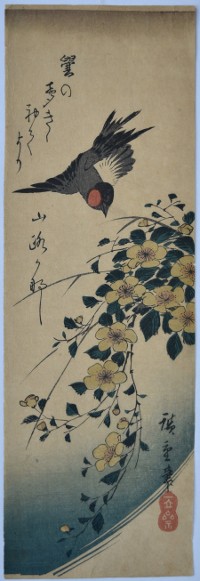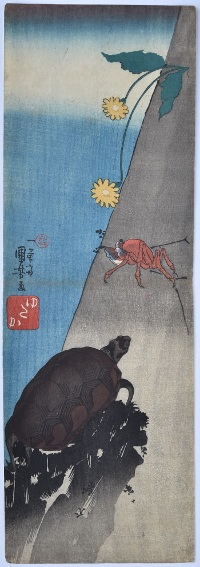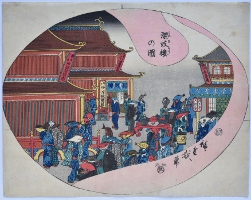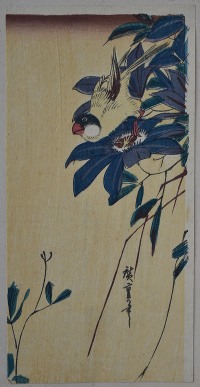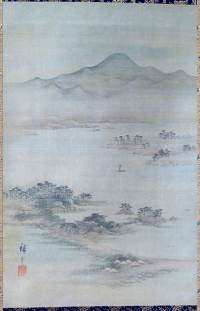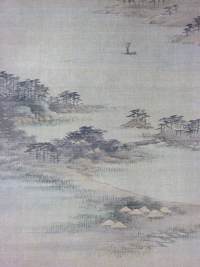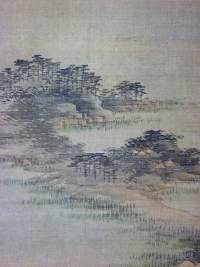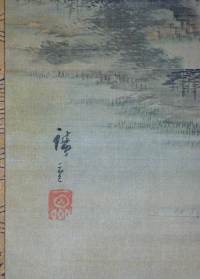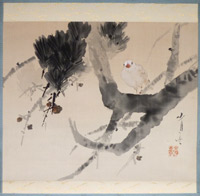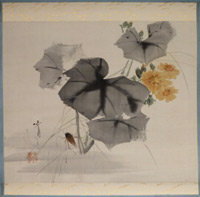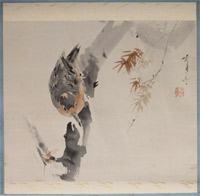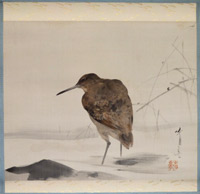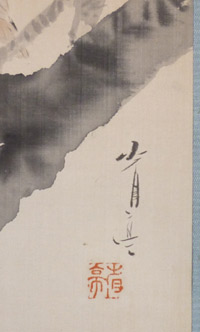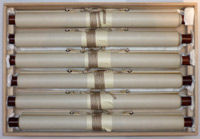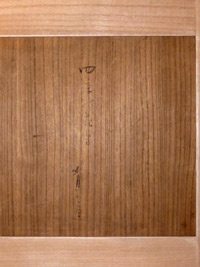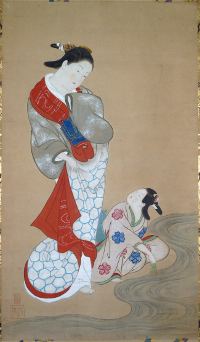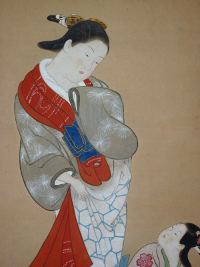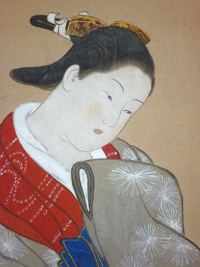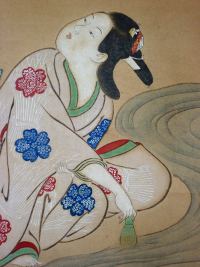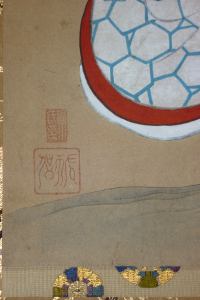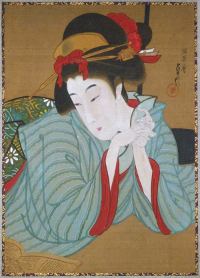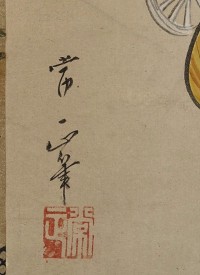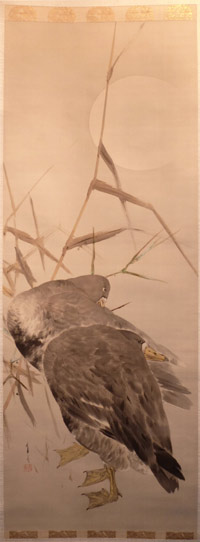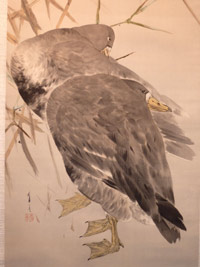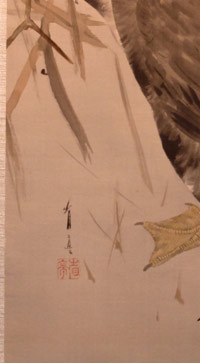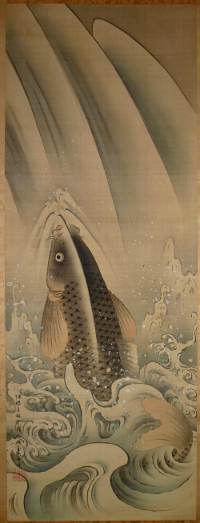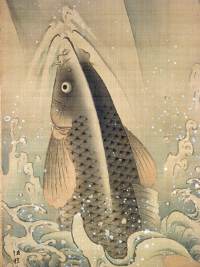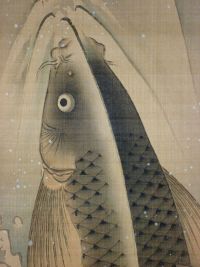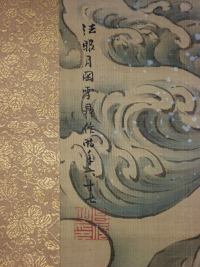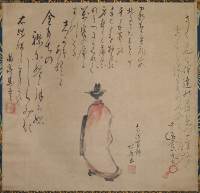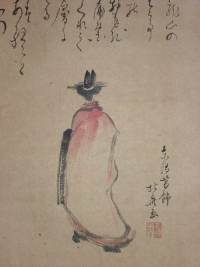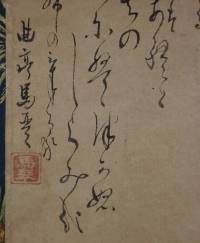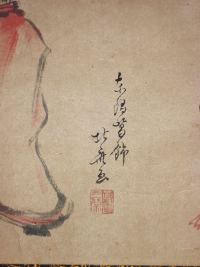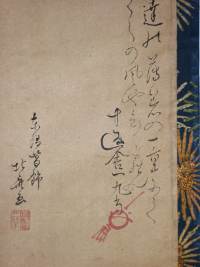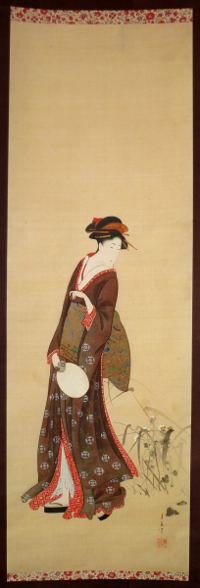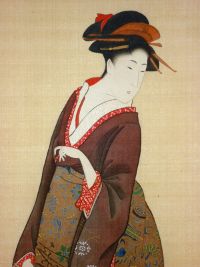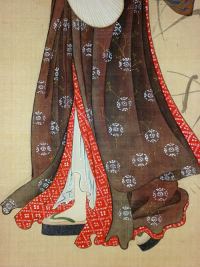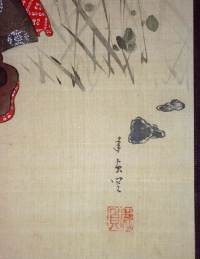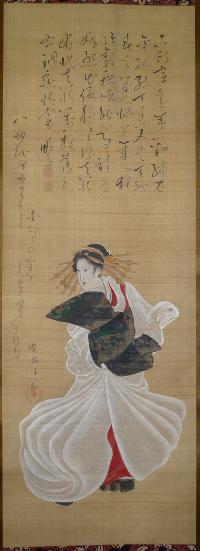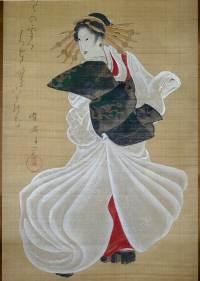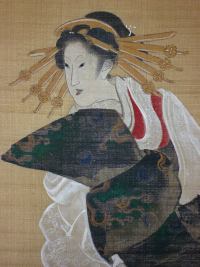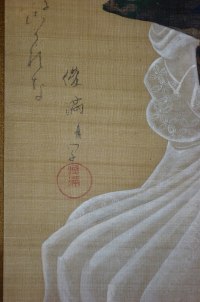/category/archive/page/2/
Utagawa KUNISADA (1785-1865)
Click here to view image full size.
An uncut fan print showing the actor Bando Takesaburo I in the role of the Sumo wrestler Shirafuji Genta from a set: Mitate gonin otoko go-hiiki omozashi, An Imaginary Five Commoners.” Published by Yama-Ta, 2ic/1852.
Superb impression with mica added to sky and burnishing. Superb colour and condition: From a group of such fans that are as the day they were first printed and must have been put together by a fan collector. Signed Toyokuni ga.
Status: Sold
Utagawa KUNISADA (1785-1865)
Click here to view image full size.
An uncut fan print showing the actor Bando Shuka I: “Snow” from a Furyu settsugekka set of Snow, Moon , Flowers. Published by Kojima Jubei (who specialised in fans) in 3/1853.
Superb impression with mica added to sky. Superb colour and condition: From a group of such fans that are as the day they were first printed and must have been put together by a fan collector. Signed Toyokuni ga.
Status: Sold
Ichiryusai HIROSHIGE (1797-1858)
Click here to view image full size.
A tanzaku showing a Japanese finch sitting on a camellia branch. Unidentified collector’s seal au verso.
Very fine impression. Fine colour and condition. Signed Hiroshige hitsu.
Status: Sold
Ichiryusai HIROSHIGE (1797-1858)
Click here to view image full size.
Ai or ayu, river trout, Plecoglossus altivelis. Poem by Haruzono Shizuo. From the first set of fish prints published by Eijudo, c 1832-4. This first series was issued privately for a poetry group ( probably the Shingyoku Circle ) with judges’ names and extra poems. These prints are of the utmost rarity as probably only enough for the Circle were printed and they never come onto the market. Due to their popularity this first series was published commercially and a second set was commissioned. The most sought after print in the series and probably the first to be designed.
Very good impression, colour and condition. Full size with with no centre fold. Signed Hiroshige hitsu.
Status: Sold
Utagawa KUNISADA (1786-1865)
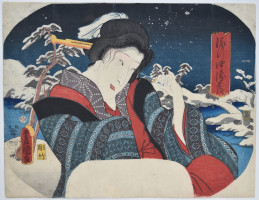
Click here to view image full size.
An uncut fan print showing a geisha adjusting her hair pin set against a snowy landscape. Fukagawa Iyo setsu, “Time in Fukugawa, Iyo Province.” Published 3/1855 by Iseba Magobei.
Fine impression and colour with splashed gofun to represent falling snow. Small expertly repaired wormhole, otherwise very good condition. Signed Toyokuni ga.
Status: Sold
Utagawa SADAHIDE (1807-1879)
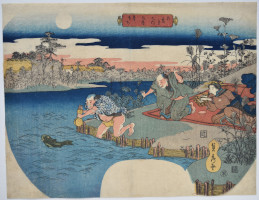
Click here to view image full size.
An uncut fan print Gosekku no uchi, kugatu, tsuki machi, “Five Festivals, Ninth Month, Moon Viewing.” Viewing the full moon in the eighth and ninth months was a popular activity passed down from the aristocracy in Heian times; especially where the moon’s reflection could be seen in water. One such party is seen here where a member vainly attempts to catch a catfish with a gourd: A hopeless task with such an unsuitable utensil. This is based on a Zen riddle posed by Ashikaga Yoshimochi (1386-1428) on how to catch a catfish with a gourd, which inspired the 15th century artist Josetsu to paint the subject with accompanying poems on the conundrum by Zen monks. Published by Iseya Ichiemon, 1835.
Fine impression and colour. Two small expertly repaired wormholes, otherwise very good condition. Signed Sadahide ga.
Status: Sold
Ichiryusai HIROSHIGE (1797-1858)
Click here to view image full size.
A half- block print showing a small bird (possibly a bush warbler) and plum blossom. . Published by Kawasho (Kawaguchi Shozo) c. mid 1830s. Half-blocks were printed two-to-a-sheet and divided, either vertically or horizontally.
Very good impression, colour and condition. Signed Hiroshige ga with Utagawa seal.
Status: Sold
Anonymous (c. 1810)
Click here to view image full size.
An uncut ukie fan print, Edo meisho Eitaibashi, “Eitai Bridge, Edo.” Published by Ibaya Sensaburo, c. early 1800s. Possibly by Utagawa Kunimitsu or Utagawa Kunitora and quite possibly the only recorded impression.
Very good impression and colour. Slight corner soil, otherwise good condition.
Status: Sold
Ichiryusai HIROSHIGE (1797-1858)
Click here to view image full size.
A half-block print showing a sparrow and iris. Published by Kawasho (Kawaguchi Shozo) c. mid 1830s. Half-blocks were printed two-to-a-sheet and divided, either vertically or horizontally.
Very good impression, colour and condition. Signed Hiroshige ga with Utagawa seal.
Status: Sold
Utagawa KUNISADA (1786-1865)
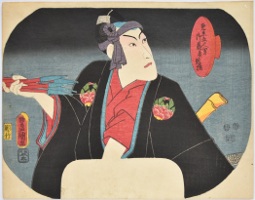
Click here to view image full size.
An uncut fan print showing the actor Ichikawa Danjuro VIII in the role of Hanakawado no Sukeroku from a set: Mitate gonin otoko go-hiiki omoizashi, “A Parody of the Five Chivalrous Commoners, a Cup of Sake from their Fans.” Shows the actor holding a number of pipes; a shakuhachi protruding from his back. Published by Yama-Ta, 2ic/1852.
Extremely fine impression and colour. Minimal soil at bottom, otherwise fine condition. Signed Toyokuni ga.
Status: Sold
Utagawa KUNISADA (1786-1865)
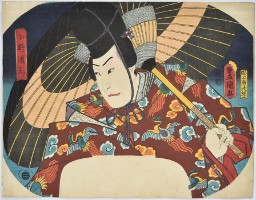
Click here to view image full size.
An uncut fan print showing the actor Sawamura Chojuro V as Ono no Tofu (aka Ono no Michikaze) in the play Ono no Tofu aoyagi suzuri performed at the Ichimura-za Theatre, 3/1850. Shows the character holding a large umbrella. Published by Ibaya Senzaburo, 1850 (who seems to have specialised in fans).
Extremely fine impression and colour with extensive burnishing. Minimal soil at bottom, otherwise fine condition. Signed Toyokuni ga.
Status: Sold
Utagawa KUNIYOSHI (1797-1861)
Click here to view image full size.
An uncut fan print from a series: Koumei matsu tsukushi, “ Famous Kinds of Pine.” A euphemism for young beauties. One here shown holding a cage for fireflies being caught by children in the background. Published by Maruya Jinpachi, 4/1854.
Fine impression, colour and condition. Signed Kuniyoshi ga.
Status: Sold
Utagawa HIROSHIGE (1797-1858)
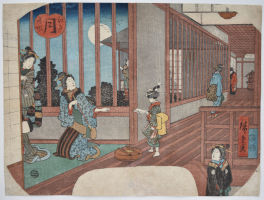
Click here to view image full size.
An uncut fan print. Moon from a setsugekka set of famous views of Edo. Shows the interior of a teahouse. Published 1849-53 by Ibaya Sensaburo.
Very good impression and colour. Restored centre bottom and other minor imperfections, but otherwise good condition. Signed Hiroshige ga. Very rare: Seemingly only two other impressions extant.
Status: Sold
Utagawa KUNISADA (1786-1865)
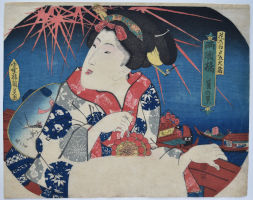
Click here to view image full size.
An uncut fan print, Ryogokubashi natsu no kei, “View of Ryogoku Bridge in the Summer” from a set Hana no Edo go-ohashi, “Five Major Bridges of Edo.” Shows a beauty on the bridge with fireworks exploding above. Fireworks became so popular in the summer that the authorities had to limit them to the river. Published by Kojimaya Jubei !843-46.
Fine impression and colour. Minor soil, otherwise very good condition. Signed Kochoro Kunisada ga.
Status: Sold
Utagawa KUNISADA (1786-1864)
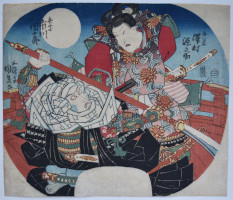
Click here to view image full size.
An uchiwa-e showing Sawamura Gennosuke II as Ushiwakamaru and Ichikawa Danjuro VII as Benkei battling on Gojo Bridge. In fact, this shows a dance with title Soga matsuri musashi no surimono from a play performed at the Kawarasaki-za Theatre, 5/1831. The dance is today called Hashi Benkei, “Benkei on the Bridge.” The story relates how Benkei, of Herculean strength, was subdued by the young Onzoshi Ushiwaka Maru (Yoshitsune) on Gojo Bridge. Benkei was wandered around Kyoto with the intention of relieving 1000 samurai of their swords. One night, with one more sword to go, he saw Yoshitsune playing a flute and wearing a golden sword at the Gojotenjin Shrine. They agreed to fight on Gojo Bridge in southern Kyoto. However, Yoshitsune was too agile for Benkei and had been educated in the secrets of fighting by the tengu. Following Yoshitsune’s victory Benkei became Yoshitsune’s retainer. Published by Ibaya Senzaburo . Rare: Possibly unique.
Fine impression and colour. Very good condition. Signed Gototei Kunisada ga.
Status: Sold
Ichiryusai HIROSHIGE (1797-1858)
Click here to view image full size.
A chu-tanzaku showing a house swallow above a trailing yellow plant.
Fine impression. Very good colour. Slight browning, otherwise very good condition. Signed Hiroshige fude.
Status: Sold
Utagawa HIROSHIGE (1797-1858)
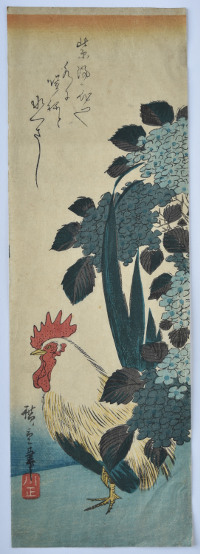
Click here to view image full size.
A tanzaku showing a rooster and hydrangea. Published by Kawaguchi Shozo, c. 1830s. Another impression is illustrated in Four Hundred Ukiyoe Woodblock Prints From The Museum Of Art, Rhode Island School Of Design, 1990, no. 121, p. 54. Hiroshige is best known for his landscapes, but he produced almost as many bird and flower prints.
Very good impression, colour and condition. Signed Hiroshige hitsu.
Status: Sold
Utagawa KUNIYOSHI (1797-1861)
Click here to view image full size.
A chutanzaku print showing a tortoise, crab and dandelions from an untitled series of ten prints showing water creatures originally published two-to-a-sheet. Of the utmost rarity: Arguably the most difficult Kuniyoshi set to find. It appears there are only three other impressions known of this design: The Bidwell Collection, Springfield Museum of Fine Arts, illustrated in their catalogue, Utagawa Kuniyoshi, 1980, no 72 (60.D05.197); The Japan Ukiyoe Museum, uncut sheet with lobster and small fish, illustrated in Utagawa Kuniyoshi Exhibition Catalogue, 1996, p. 154, no. 208; and Kuniyoshi, Iwakiri Yuriko, Hotei publishing, 2013, p. 135, no. 109 (possibly from a French collection). This actual impression (making the fourth impression known) is illustrated in Kuniyoshi, Juzo Suzuki, 1992, no. 445. Ex collections J. Schedel (seal next to signature) and Sawai Suzuichi. This impression has no publisher’s seal nor does another design of a carp from the set illustrated in Heroes & Ghosts, Robert Schaap, Hotei publishing, 1998, p. 213, no 240. That is a very fine impression (as is this) and possibly they are proof impressions. Published by Tsujiokaya Bunsuke (Kinshodo), c 1837. For the full set illustrated see the Springfield catalogue mentioned above. Excessively rare.
Very fine impression with woodgrain showing on all blocks. Fine colour. Centre fold (evident if held to light), otherwise very good condition. Signed Ichiyusai Kuniyoshi ga with Yutaka seal.
Status: Sold
Ichiryusai HIROSHIGE (1797-1858)
Click here to view image full size.
An uncut fan print with title Shinkiro no zu which has a double meaning of being the Yoshiwara in the deep sea and also a chimera or mirage. The scene enclosed in a (dreaming ?) bivalve shows visitors in a watery Yoshiwara, all with fish heads. Of the utmost rarity: This appears to be the only impression known. There are also what appear to be keying marks on three sides that have not been removed. Published by Shinagawaya Kyusuke with censor seal for 1845.
Very fine impression. Fine colour and condition. Signed Hiroshige giga hitsu.
Status: Sold
Utagawa HIROSHIGE (1797-1858)
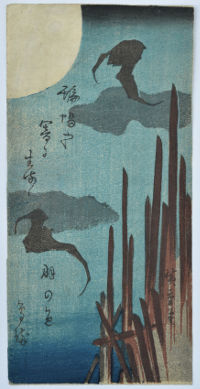
Click here to view image full size.
A small tanzaku showing bats flying against a full moon above a lumberyard. A poem reads: “The colour of the bats’ wings was born in darkness.” Published c. late 1830s. Rare: Another impression is illustrated in Japanese Prints IV – Hiroshige and the Utagawa school, the Rijksmuseum, 1984, 46 61:35, p. 35.
Very good impression, colour and condition. Signed Hiroshige hitsu.
Status: Sold
Utagawa HIROSHIGE (1797-1858)
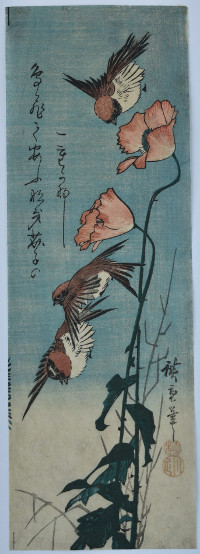
Click here to view image full size.
A chu-tanzaku showing sparrows and poppies. Published by Kawaguchiya Shozo, c. late 1830s. A poem: Tori tonde (tobite) / abunaki keshi no / hitoe kana, “ A bird flying by / poses danger to poppies / with single layers of petals.” The same poem is used on another chu-tanzaku showing a bluebird and poppies, see MET Museum, JP2532. Other impressions of this print are in Honolulu Museum of Art, 18009; MFA, Boston, 21.8018; Chazen, University of Wisconsin-Madison, 1980.1887.
Very good impression and colour. Very small expertly restored wormholes, otherwise very good condition. Signed Hiroshige hitsu.
Status: Sold
Utagawa HIROSHIGE (1797-1858)
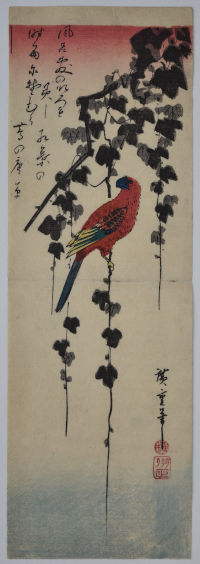
Click here to view image full size.
A tanzaku showing a parrot perched on hanging ivy. Published c 1830s by Kawasho (Kawaguchi Shozo).
Fine impression and colour. Centre fold, otherwise very good condition. Signed Hiroshige hitsu.
Status: Sold
Utagawa HIROSHIGE (1797-1858)
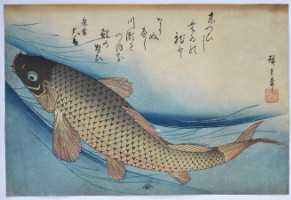
Click here to view image full size.
A koi, carp (Cyprinus carpio) swimming amongst reeds. Poem by Makuzu. From the second series of ten fish prints published by Yamasho, c. 1840-42. The first series was issued privately for a poetry group (probably the Shingyoku Circle) with judges’ names and with extra poems. These prints are of the utmost rarity as probably only enough for the Circle were made and they never come onto the market. Due to their popularity this second set was commissioned. This is the very rare first edition with the reeds printed. Block defect showing but with gradation still on belly of fish. One of the finest designs from the two series. Very rare. Kruml 12a/b.
Fine impression. Slight fading and edge soil, otherwise very good condition. Without centre fold (in itself rare as they often have them). Signed Hiroshige hitsu.
Status: Sold
Utagawa HIROSHIGE (1797-1858)
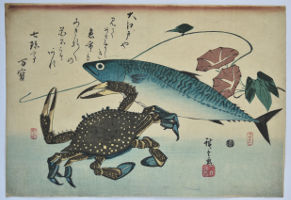
Click here to view image full size.
A kami, crab (Charybois), and saba, mackerel (Scomber Japonicus), together with two flowers of morning glory. Poem by Shichichintei. This is the first edition (Kruml 19a). From the second series of ten fish prints published by Yamasho, c. 1840-42. The first series was issued privately for a poetry group (probably the Shingyoku Circle) with judges’ names and with extra poems. These prints are of the utmost rarity as probably only enough for the Circle were made and they never come onto the market. Due to their popularity this second set was commissioned.
Fine impression, colour and condition. Signed Hiroshige ga.
Status: Sold
Utagawa SADAHIDE (1807-1873)
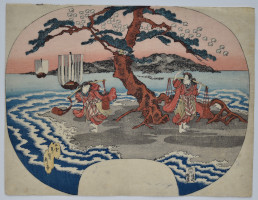
Click here to view image full size.
An uncut fan print showing the two brine-gathering maidens of Suma Bay: Matsukaze “Pine Wind”and Murasame “Drops of Rain.” Published by Tsuruya Kiemon, c early 1840s. Rare.
Very good impression, colour and condition. Signed Gountei Sadahide hitsu.
Status: Sold
Ichiryusai HIROSHIGE (1797-1858)
Click here to view image full size.
A Java sparrow on a clematis vine. A sanchogake format (three designs printed on a horizontal sheet and intended to be separated). Published c 1835-9. Rare.
Very good impression, colour and condition. Signed Hiroshige hitsu. (There is an impression with a cube-shaped red Hiroshige seal which is the first state.)
Status: Sold
Utagawa KUNISADA (1786-1865)
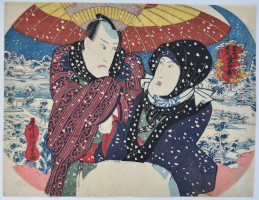
Click here to view image full size.
An untrimmed fan print Fuji Tsukuba aiaigasa, “Fuji and Tsukuba Sharing an Umbrella.” A play on images and words: Shows the actors Nakamura Shikan II and the onnagata actor Iwai Kumesaburo II sharing an umbrella against the snow. Tsukuba, about 50 kilometers from Edo, was an area where both Fuji and Mount Tsukuba could be viewed together. Mount Fuji being the female and Mount Tsukuba the male. An aizuri-e background (common to all the designs in this set). Published by Ibaya Senzaburo, c 1829. (The publisher’s seal is on the umbrella on the following design from this set. He published a number of Kunisada’s fan sets.) Rare.
Very fine impression with extensive burnishing. Fine colour. Several expertly repaired binding holes, otherwise fine condition. Signed Kochoro Kunisada ga.
Status: Sold
Utagawa KUNISADA (1786-1865)
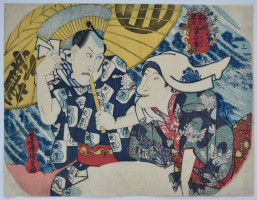
Click here to view image full size.
An untrimmed fan print Fuji Tsukuba aiaigasa, “Fuji and Tsukuba Sharing an Umbrella.” A play on images and words: Shows the actors Ichikawa Ebizo V and the onnagata actor Iwai Shijaku I sharing an umbrella against the wind. Tsukuba, about 50 kilometers from Edo, was an area where both Fuji and Mount Tsukuba could be viewed together. Mount Fuji being the female and Mount Tsukuba the male. An aizuri-e background (common to all the designs in this set). Published by Ibaya Senzaburo, c 1829 – the publisher’s seal is on the umbrella. He published a number of Kunisada’s fan sets.) Rare.
Very fine impression. Fine colour. Several expertly repaired binding holes, otherwise fine condition. Signed Kochoro Kunisada ga.
Status: Sold
Gyokurantei SADAHIDE (1807-1873)
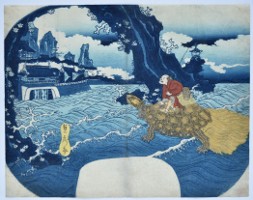
Click here to view image full size.
An uncut aizuri-e fan showing Urashima Taro astride a large turtle approaching the Dragon King’s Palace. The story relates how the fisherman rescues the turtle from some miscreant children on a beach. A few days later, while fishing, the turtle appears and rewards him by taking him to the palace (Ryugu-jo Castle) where he is thanked by Princess Otohime, the King’s daughter. After a few happy days he wishes to return to his village but discovers he has, in fact, been away for 100 years and become an old man. Extremely rare: Possibly the only known impression. Provenance: Ex collection Toni Strauss-Negbaur, seal au verso.
Very good impression and colour which is mainly aizuri with colour on Urashima and the turtle. Restored centre fold and slight edge soil, otherwise good condition. Signed Sadahide ga.
Status: Sold
Ichiryusai HIROSHIGE (1797-1858)
Click here to view image full size.
An original painting, sumi and light colour on light green-coloured silk, 21.37 x 13.62 in; 51.8 x 34.7 cms. The location is unidentified but shows an inland sea with a promontory and shrine. A beautiful, lyrical landscape probably painted in Kaei era (1848-54). In good condition and has recently been remounted with a futo-maki wooden role. Signed Hiroshige with Ichiryusai seal.
Status: Sold
Watanabe SEITEI (1852-1918)
Click here to view image full size.
A complete set of 12 paintings showing birds and plants representing the months of the year. Seitei ( Shotei ) specialised in kachoga; was famous in this area, and regarded as the leading exponent. Technically brilliant. January shows a dove on a pine tree with pine cones. February depicts narcissus. March is represented by cherry blossom. April is a display of yamabuki, Japanese mountain rose, with bees. May shows a cuckoo with a falling ginkgo leaf. June is wisteria and a butterfly. July has a beetle climbing a leaf on an iris plant. August shows Japanese morning glory, Asagao. September has a grasshopper on an edamame ( soybean ) plant. October appears to be a wild chrysanthemum and beetle. November depicts what is probably a nuthatch climbing down a tree. And December is represented by a snipe. Each painting sumi and colour on silk. Image size 33.8 x 27.4 cms; 13.25 x 10.75 in. Each painting signed and sealed Seitei. Matching mounts. Slight staining on one or two paintings ( primarily July ) otherwise in very good condition. New box but retaining original lid with Seitei signature and seal and inscription Shiki no kacho, “Birds and Flowers of the Four Seasons.” It is rare to find complete sets of such paintings which are usually conceived as handscrolls.
Status: Sold
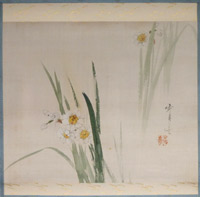
Click here to view image full size.
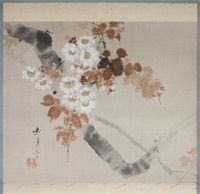
Click here to view image full size.
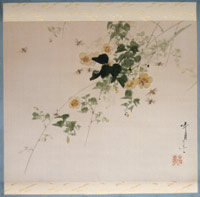
Click here to view image full size.
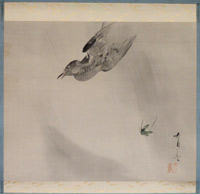
Click here to view image full size.

Click here to view image full size.
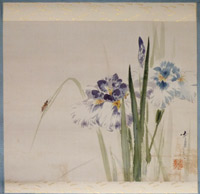
Click here to view image full size.
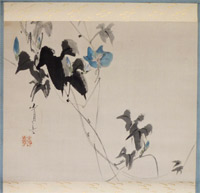
Click here to view image full size.
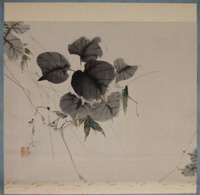
Click here to view image full size.
Nishikawa SUKENOBU (1671-1750)
Click here to view image full size.
The pre-eminent painter in the Kyoto area during the first half of the eighteenth century. He enjoyed a great reputation in his lifetime and his (over 100) illustrated books influenced many artists, not only in the Kyoto-Osaka area but also in Edo. Many of his books were published by Hachimonjiya in Kyoto such as Hyakunin joro shina sadame (1723). Other famous books being: Tokiwa gusa (1731); Asakayama (1739); Chiyomi-gusa (1740). His paintings were collected by his contemporaries with Yanagisawa Kien (in his Hitorine, c. 1726) calling him the “supreme master” of Ukiy-e, superior to Okumura Masanobu, Torii Kiyonobu, Hanekawa Chincho and Kaigetsudo. Full colour on silk, 30.25 x 17.5 in; 76.7 x 44.3 cms. Shows a typically refined and elegant beauty watching her assistant washing a tea-whisk in a stream. Suihen bijin zu. There are two other versions of this design by Sukenobu: One was auctioned in 1933 at the Osaka Art Club from the W. Sturgis collection and there is another from Nagano, Japan, illustrated in Kokka, no. 18, 2011, p. 10. Other examples are in major museums such as the Metropolitan, Philadelphia, Freer, Honolulu, British, etc. Although Sukenobu produced many paintings, genuine works are now rare. Painted c late 1730s. Minor marks and creases and some loss of gofun, but in very good condition for an early 18th century painting. Sealed Nishikawa shi in and Sukenobu. Illustrated and exhibited in Nikuhitsu Ukiyoe Beauty, Tokyo Fuji Art Museum, 1983, no. 21, ex Hirano collection, Akita Prefecture.
Very good condition. Signed and sealed Bokusen. See my Blog on this update.
here
Status: Sold
Hasegawa SADANOBU II (active 1867-1880s)
Click here to view image full size.
An original painting by Sadanobu II. A reclining beauty reading a book. There appears to be nothing else like this by Sadanobu, and indeed, there are very few bijin-ga prints by him. A beautiful painting.
Sumi and colour on silk. Image size 13 x 9.25 inches; 33 x 24 cms. Slight loss of gofun and minor marks. Mounted onto board.
Signed Ho Utamaro Sadanobu, “copied [ or imitating ] Utamaro, Sadanobu” with Sadanobu seal.
Status: Sold
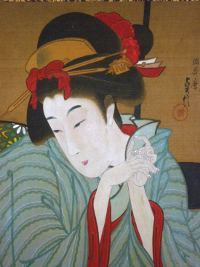
Click here to view image full size.
Toensai KANSHI (Fl. mid-18th century)
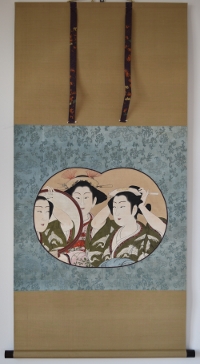
Click here to view image full size.
A rare, highly talented and enigmatic painter who produced only a few masterpieces. There is some confusion over his active working life with differing dates from 1748 to 1780, but he was certainly painting in the 1760s. This unusual composition shows a beauty adjusting her hair by obliquely looking in a mirror held by her maid who stares unnervingly straight at the viewer. This painting is well known and is illustrated in Nikuhitsu Ukiyoe, Collection of Ukiyo-e Paintings Classified by Artist and Schools, Vol. 4 (of 10): Katsukawa school, Suzuki Harunobu and Isoda Koryusai, pl. 83, edited and published by Shueisha, 1982. It is also mentioned on page 113 in Ukiyo-e Large Encyclopaedia, Vol. 2, edited by Japan Ukiyo-e Society, published by Taishukan, 1982. Another Kanshi painting showing a beauty collecting bamboo shoots in the snow was exhibited at the Metropolitan Museum of Art, NY, in 2014, in an exhibition: The Flowering of Edo Period Painting: Japanese Masterworks from the Feinberg Collection.
Full colour on paper with mica on the mirror, image size 14.5 x 20 in; 37 x 51 cms. In extremely good condition with double box. Painted c 1765.
Status: Sold
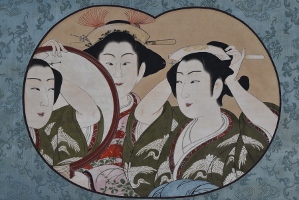
Click here to view image full size.
Kawamata TSUNEMASA (Fl. 1716-48)

Click here to view image full size.
Shows a beautiful salt-water gatherer, her hut behind her on the seashore. A member of the Kawamata school, he probably worked in Kyoto and specialised in bijinga.
Sumi and full colour on paper. Outlines picked out in gold. 32.5 x 10.5 in; 82.5 x 26.5 cms. Fine old brocade mount. Old box. Signed and sealed Tsunemasa.
Status: Sold
Watanabe SEITEI (1851-1918)
Click here to view image full size.
Two geese – possibly Greater White-fronted Geese ( although the legs should be a little more orange ) with tall reeds and a large misty moon. Sumi and light colour on silk, 43 x 16 in; 109 x 40.5 cms. Signed and sealed Seitei. In fine condition with original box signed and sealed by Seitei.
Status: Sold
Tsukioka SETTEI (1710-1786)
Click here to view image full size.
An original painting, sumi and light blue on silk. Image size 38.75 x 14.25 in; 98.4 x 36.2 cms. Shows a carp leaping a waterfall. This was a favourite subject for Japanese artists being a symbol of achievement against adversity. Carp were bred for their colour in Japan and, interestingly, Koi that are returned to the wild revert back to their grey colour. They are known to live for up to a hundred years or more. Settei produced many illustrated books but after around 1765 turned to painting beauties, courtesans and geishas. They are of the utmost refinement – the faces and limbs picked out in red, their costumes with areas of gold, and invariably have the wide lantern-locks (toro-bin) hairstyle. Signed Hogen Tsukioka Sessai jinen rokuju-nana (painted aged sixty-seven, hence 1777). Seal Masanobu no in. In good condition with splashed gofun.
Status: Sold
Katsushika HOKUSAI (1760-1849); Kyokutei BAKIN (1767-1848); Jippensha IKKU (1765-1831)
Click here to view image full size.
An original painting by Hokusai showing the back view of a courtesan. Above are inscriptions by Bakin and Ikku, the two leading writers of the day. ( Bakin is famous for writing Chronicles of the Eight Dog Heroes of the Satomi Clan of Nanso and Ikku for writing the most humorous book in the Japanese language: Shank’s Mare Journey on the Tokaido.) This painting was originally sold at the Tokyo Bijutsu Club, December 3rd, 1928. It is illustrated in Katsushika Hokusai Paintings, Mainich Shimbun, 1975. It is signed Toyo Katsushika Hokusai ga, “Painted by Katsushika Hokusai of Orient” and the seal, Katsushika Hokusai, is the same seal as that used on the pair of hand scrolls, Day and Night, in the Museum of Fine Arts, Boston. Colour and sumi on paper, 11.12 x 11.5 in; 28.2 x 29.2 cms. An intriguing old mount and sold with original sales slip from 1928 and a copy of the 1975 catalogue.
The inscriptions translate as:
I went out dressed up very lightly just to show off for the sake of cherry blossom viewing party.
However, I ended up catching a cold and all my efforts to enjoy the cherry blossoms went for nothing.
Jippensha Ikku
Yoshiwara is located in the north of Mount Kinryu, and it is a very grassy place.
Here I live inside the fence of Miuraya,
I am worshiped by so many guests.
Even though I devote myself completely to seek popularity every day,
I am a louse whose heart cannot be stolen by money alone.
This is my mettle as a courtesan.
Kyokutei Bakin
Status: Sold
Utagawa HARUSADA (1830-1887)
Click here to view image full size.
An exceptionally beautiful painting of a standing beauty by this pupil of Kuniyoshi. An ukiyo-e artist who worked in Kyoto. Real name Okamoto Syotaro. Full colour with touches of gold on silk. Image size 40.5 x 13.5 in; 102.8 x 34.2 cms. Very minor brown area otherwise in fine condition. Signed Harusada ga. Seal unread.
Status: Sold
Kubo SHUMMAN (1757-1820) and Kameda BOSAI (1752-1826)
Click here to view image full size.
An original painting showing a parading oiran on the first day of the eighth month, Hassaku (hachigatsu sakuhi). It was common on this day to wear a white kimono. This festival still takes place in the Gion quarters of Kyoto. The calligraphy, above, is by Bosai (Hosai), an amateur artist and noted scholar and writer. Full colour on silk, 35.25 x 12.5 in; 89.5 x 31.7 cms. In good condition. Signed Shumman painted by himself with Shumman seal.
Status: Sold
